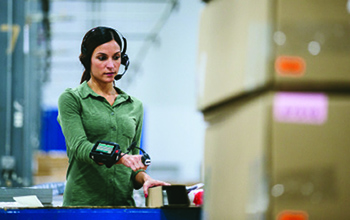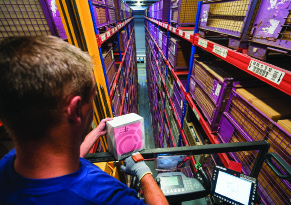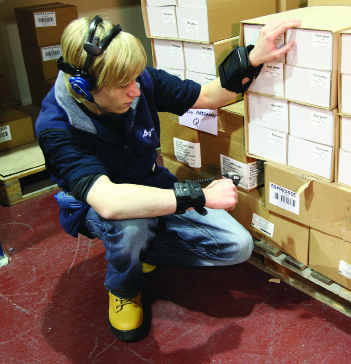Information Management: Wearables come in for a refit
Wearable technologies are nothing new in warehouses. For decades, equipment such as ring scanners, arm-mounted devices, and voice headsets and terminals have made warehouse processes more productive and accurate. That doesn’t mean, however, that wearables are standing still.
Providers of data collection hardware say the more purpose-built wearables of the past have evolved through capabilities including touchscreens and increased use of the Android operating system (OS) to become more flexible, capable devices.
Today’s wearables are rugged mobile computers that can drive multiple modes of data collection and interaction. At the same time, new forms of wearables such as smart glasses and smart watches are starting to see use. Wearables can make workers involved in tasks like picking, replenishment and packing more productive because they don’t interrupt workflows to the same extent they would if they had to fully manipulate a handheld.
“The fundamental attraction for wearables in industrial settings is that people can work in more of a hands-free and heads-up manner with better access to information as they carry out their work,” says Ryan Martin, senior analyst at ABI Research. “That hands-free nature of wearables leads to productivity gains and can help accuracy, especially versus more manual processes like using paper pick lists.”
ABI estimates that uptake for enterprise wearables will grow at a 35% compound annual rate through 2021 to reach 151 million units shipped that year. That’s up from about 35 million units shipped in 2016. This includes a range of devices: wearable mobile computers, ring scanners, smart glasses, smart watches and also specialized wearables for medical monitoring.
ABI expects warehousing and manufacturing will be two of the more attractive markets for wearables, receiving 34% of smart glass and wearable scanner shipments through 2021. “Companies are likely to first introduce wearables into some of their heavier cost centers for labor and data collection, prove the savings and then roll out the devices on a broader basis,” says Ryan.
While rugged, radio-frequency (RF) handhelds remain vital to warehouses, the need to be highly productive in the face of more e-commerce picking is driving interest in wearables, according to Bruce Stubbs, director of supply chain marketing with http://sensing.honeywell.com/.

“There really is a trend toward more hands-free type of applications, including voice and wearables,” says Stubbs. “A wearable computer with a ring scanner also can be used alongside voice, with the voice system providing the productivity benefit of directing workers to the correct location and what to pick, and using the wearable computer with scanning to easily capture additional critical data.”
Wearables for the warehouse include arm- or wrist-attached mobile computers that are often paired to a Bluetooth ring scanner; gloves that have scan capability built in; and voice terminals and headsets. Some of these technologies such as ring scanners and arm-mounted computers have been around for many years, though they’ve evolved in areas like touchscreens, processing power, and increasingly, being Android based.
Some of the newer wearables promise groundbreaking capabilities. Smart glasses can overlay the physical reality of what a worker sees with digitally rendered images or information creating what is known as augmented reality (AR). Meanwhile, the new rugged wearables typically have advanced Bluetooth support and other feature sets that can help with real-time positioning of assets or workers in a warehouse. So even as the more traditional wearables evolve, new uses such as AR-based, pick-to-light (PTL) or precision tracking of workers carrying devices are poised for use in the warehouse.
Mainstays evolve
Arm-mounted computers are smaller, more powerful and more flexible in the duties they can handle than ever before, say providers.
Mark Wheeler, director of supply chain solutions for Zebra Technologies, points out that wearables such as Zebra’s WT6000 mobile computer and its RS6000 ring scanner have improved in several ways over earlier generation products. The WT, for example, is a small and light Android-based device that improves ergonomics, while the RS600 is totally wireless with an aggressive scan engine and 2D imaging unit that offers longer scan range. That longer scan capability makes the unit better suited to tasks such as case picking or reading location placards, rather than only close-up scans.
“Generally, customers are aggressively adopting wearables because of the productivity and accuracy gains that come from aligning how the technology is used with task ergonomics,” says Wheeler.
The rugged wearables of today are more like smart phones in their use of Android and touchscreen capability than the terminals of the past. This makes them better at accessing apps or viewing metrics. Yet, vendors maintain the ruggedness, battery life and device management features that users of industrial devices are accustomed to. For users to gain full advantage of features like touchscreens, however, older data collection applications based on keypad entry might need to be reworked.
Zebra has partnered with Wavelink to provide users with a software tool that interprets older applications and converts them to have touchscreen capability without rewriting the apps. The warehouse management system (WMS) or other host system doesn’t need to be changed, because the tool essentially interprets and “renders” touchscreen functions without touching host system code, Wheeler explains.
At Honeywell, its latest Dolphin line of arm-mounted wearables is based on a touchscreen wearable computer form factor rather than a keypad-driven terminal designed solely as a wearable, says Stubbs. The devices can come with phone capability as an option, and the units can be easily removed from their wrist mounts to be used for other work roles in a warehouse. “We didn’t create a device that could only be worn on the wrist,” says Stubbs. “The reason is our customers were telling us they like to be able to maintain flexibility.”
Android-based smart phones are coming on strong as wearables to support voice picking, observes Ron Kubera, executive vice president and chief marketing officer for Lucas Systems, a provider of mobile work execution software that includes mobile voice-directed applications. Today, about 75% of Lucas Systems’ Move mobile applications are deployed on Android-based smart phones, says Kubera, and this is likely to accelerate in part due to disruption around sunset plans for older Windows-based mobile operating systems, but mainly because the newer rugged Android smart phones are so capable.
While Lucas always has been hardware independent with its solutions, and supports multiple OSs, the newer smart phones differ from older voice terminals in that they have more processing power and memory; bigger, better touchscreen interfaces; and built-in support for the latest Bluetooth and Near Field Communications (NFC) standards that allow them to support “multimodal” mobile solutions that combine voice, scanning, display information, NFC data capture and Bluetooth communication with other wearable accessories, such as smart watches or RFID readers. “We apply voice where voice makes sense, but also look to leverage other kinds of technologies to complement our solutions and make them more effective,” says Kubera.
For example, a Bluetooth ring scanner paired with a smart phone can be used to scan an employee badge or scan a bar code to accelerate a process as part of the Move smart phone application that interacts with WMS, labor management or work execution solutions. Lucas also supports Android smart watches as adjunct devices, so that a user can quickly glance at a watch to confirm information conveyed by voice. For example, says Steve Yurick, Lucas Systems director of speech and mobile technology, if a picker gets a voice instruction for a pick a few aisles away, and wants to reconfirm the bin location once in the aisle, a smart watch can be a quick way to do that without having to repeat the voice instruction. “Sometimes it’s more efficient just to be able to glance at a watch,” says Yurick.
New capabilities
Smart glasses are another relatively new category of wearable. Despite Google’s pull back from selling smart glasses, vendors such as Vuzix offer smart glasses that are used in multiple markets, including warehousing and logistics. According to Lance Anderson, vice president of enterprise sales for Vuzix, an advantage of smart glasses over other wearables is that they are completely hands free, with no need to point a ring scanner or tilt a forearm-based wearable to view information, because the camera-based scan engine and user interface are part of the glasses and the worker’s field of view. “It’s truly a heads-up, hands-free activity,” he says. 
Vuzix’s current generation of smart glasses for warehouses has been used successfully by logistics company DHL in The Netherlands for vision-based picking, with more pilots underway in Ohio and the United Kingdom. According to Vuzix, DHL’s initial deployment of vision picking drove a 25% increase in efficiency versus the previous method.
With feedback from early users, Vuzix’s new M300 smart glasses are gaining several improvements, says Anderson, including an improved hot swappable battery and greater modularity in the components. The modularity helps lower solution costs, says Anderson, because if something breaks, it’s easier and less expensive to replace a smaller component.
By early 2017, says Anderson, Vuzix will introduce smart glasses with a “see through” lens capability that allows for advanced AR capabilities. The killer app for these glasses may be virtual or “AR” put walls and PTL systems that forego the lights and computing infrastructure needed for PTL, and mimic that with the AR capability of the glasses and a few simple labels on a put wall or shelf system. “The benefit is that you can be very fluid deploying these,” says Anderson. “If a company needs 20 put walls for a peak season, they can have them quickly and at very low cost.”
Major vendors of industrial computing devices such as Zebra and Honeywell don’t rule out smart glasses for the warehouse, though they currently do not offer them. Zebra did offer a wearable headset computer called the HC1 with a visual display, but it discontinued the product, which mainly was aimed at maintenance technicians. According to Wheeler, Zebra learned from the HC1 and is taking that experience forward in the lab, but has no formal announcement on smart glasses.
For smart glasses to really take hold in warehousing, says Anderson, more applications are needed from providers with deep expertise in warehouse integration and systems. While SAP is a Vuzix partner and has a smart glasses app called SAP AR Warehouse Picker, the use of devices should accelerate once some of the warehouse integration firms begin writing apps for smart glasses, says Anderson. Vuzix is already collaborating with a couple of integrators that have deep knowledge of picking and other warehouse processes, as well as necessary integration with WMS and warehouse control systems, he adds. Integrators with warehouse experience are in a good position to develop smart glass apps such as AR-based put walls, says Anderson, because they understand the integration points to underlying systems and all the exception handling that might need to occur.
The potential for smart glasses in the warehouse should also improve as real-time location technology such as Bluetooth beacons gain acceptance, says Anderson. These beacons are small digital devices that communicate with devices that support Bluetooth Low Energy (BLE), such as smart glasses or wearable computers. In theory, BLE beacons placed throughout a warehouse could provide real-time location information on compatible devices that come within range, including smart glasses. “Location services in warehouse are very important, but they are still growing up,” says Anderson.
Already, newer wearable computers are able to communicate Wi-Fi signal strength data, allowing solutions to approximate the real-time location of a device. Using software that quickly triangulates signal strength data between a device and the various Wi-Fi access points in a facility, the current location of the wearer can be determined, explains Lucas Systems’ Yurick. That is useful for purposes such as pick path optimization, he explains. Lucas is also using other technology such as NFC built into smart phones, or having workers wear miniature radio frequency identification readers that would detect tags, to even more closely pinpoint the real-time position of workers for purposes of pick location verification.
Precision positioning
Real-time location tracking using either wearable tags and feature sets of wearables like BLE support could support a type of automatic, real-time knowledge of where people and assets are in a warehouse. But is this technology ready for prime time in warehousing?
The short answer may be that real-time positioning is getting better, but has yet to attain the proven, low-cost nature of bar code-based location validation. However, real-time location “awareness” promises a level of accuracy and elimination of data collection tasks that bar coding can’t match. There also is no doubt that real-time positioning overlaps with the wearable device trend. In some cases, a small tag or beacon can be worn by a person, or placed on an asset like a lift truck to enable positioning. In other cases, a wearable device’s feature set, like support for Bluetooth or its ability communicate Wi-Fi signal strength, are tapped to calculate location.
Steve Rattray, CEO of PLUS Location Systems, says his company’s active real-time locating solution uses small Ultra Wide Band and Bluetooth tags to enable positioning. The tags can be worn by a worker or placed on an asset. The potential warehouse uses include accident prevention, determining labor utilization, asset location, reporting near misses, and optimizing labor resources. PLUS also is working on adapting its technology so that a tag worn on a picker’s glove would enable precise knowledge of pick movements, says Rattray.
There are multiple technologies, some of them wearable that can be used for positioning, explains Cyril Houri, CEO of Accuware, a vendor of real-time positioning technology. Wi-Fi triangulation is a good basic method for indoor positioning, Houri says, but does not provide the accuracy that can be achieved with visual, camera-based positioning.
Accuware offers a visual positioning system option that provides mobile device location in three dimensions with an accuracy of a few inches, using bar codes or beacons as markers that a camera would read to reveal location data. Camera-enabled positioning can be used by mobile vehicles, such as lift trucks and autonomous mobile picking robots, he adds. “There are multiple ways you can enable locationing,” says Houri. “The method you choose depends on the accuracy needed and the application.”
ABI’s Martin believes real-time positioning by leveraging wearable tags, beacons, or device feature sets are a promising technology area, but companies will have to dig down into how much infrastructure and analytics are needed to create an operational advantage from the data. “There definitely is potential there [with location awareness], but it might be more in the future at this point because companies will need to have certain devices or infrastructure in place to surface the data, and then also have the software and analytics to drive alerts or decisions based on the location data,” Martin says.













